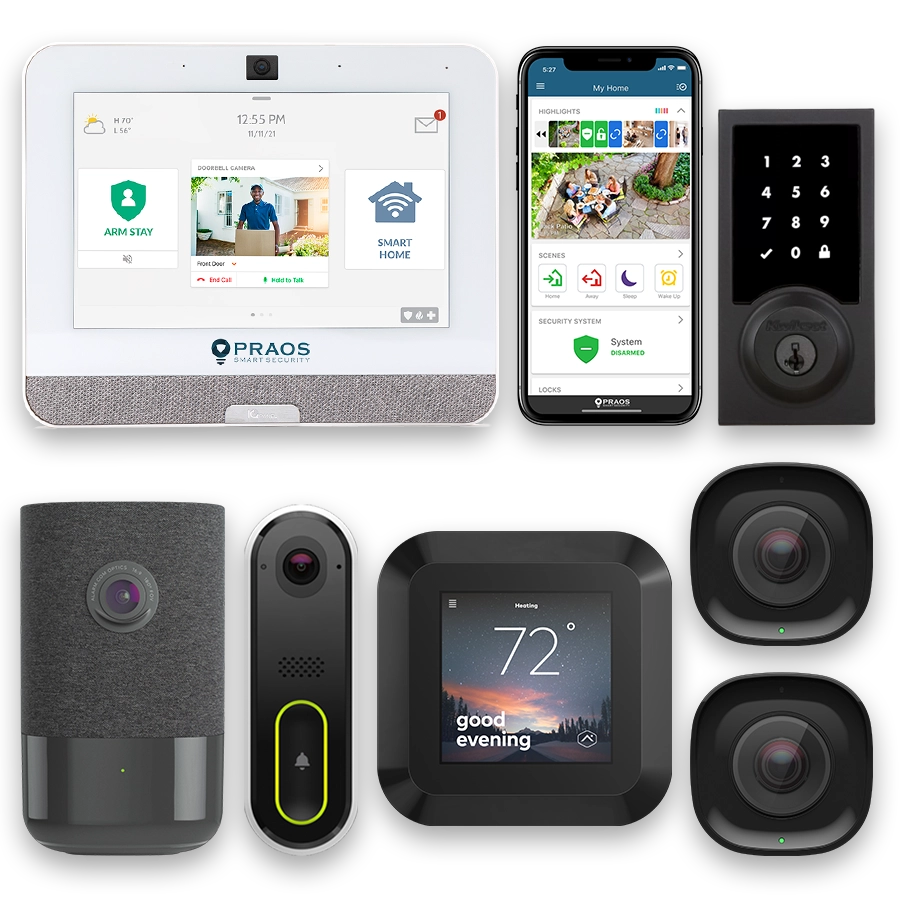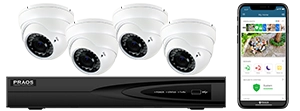Introduction to Smart Home Security Systems
In recent years, the advent of smart home security systems has brought significant advancements in the way homeowners protect their properties. These systems leverage modern technology to offer a suite of features that improve security, convenience, and peace of mind. Comprehensive smart home security systems typically include components such as cameras, motion sensors, smart locks, and alarm systems, all of which can be monitored and controlled via a smartphone app or a central hub.
Smart home security systems are designed to be user-friendly, with easy installation processes that do not always require professional assistance. Most systems are customizable, allowing homeowners to select specific components that meet their unique security needs. The convenience of remote monitoring and control is a major selling point, enabling users to keep an eye on their property from anywhere in the world.
A significant benefit of these systems is their ability to integrate with other smart home devices, creating a cohesive and automated home environment. For instance, smart lights can be programmed to turn on when motion is detected, and smart thermostats can be automatically adjusted based on occupancy patterns detected by security sensors.
Moreover, smart home security systems often come equipped with advanced features such as facial recognition, voice control, and artificial intelligence-driven analytics. These features add layers of security and enhance the overall user experience. The integration of AI can help in recognizing unusual patterns and potentially preventing security breaches before they happen.
It is important to note that the effectiveness of a smart home security system also depends on regular updates and maintenance. Ensuring that your system’s firmware is up-to-date and that all components are functioning correctly can prevent vulnerabilities that might otherwise be exploited by intruders.
Overall, the introduction of smart home security systems represents a significant leap forward in home protection, offering comprehensive, customizable, and user-friendly solutions to enhance the safety and security of homes. As technology continues to evolve, these systems are likely to become even more sophisticated, offering even greater protection and convenience to homeowners.
Enhancing Home Safety and Crime Deterrence
One of the primary advantages of installing a smart home security system is its capacity to enhance home safety and deter crime. These systems employ advanced technologies that offer multiple layers of protection.
Enhanced Safety Features
Smart home security systems are equipped with a variety of enhanced safety features that traditional systems may lack. These features include:
- High-definition cameras with night vision capabilities
- Motion detectors that can sense movement both inside and outside the house
- Smart locks that can be controlled remotely
- Automated lighting systems that can deter potential intruders
- Window and door sensors that trigger alarms when disturbed
Crime Deterrence
The visible presence of a smart home security system acts as a significant deterrent to potential burglars. Studies have shown that homes without security systems are more likely to be targeted.
| Statistic | Impact |
|---|---|
| Homes without security systems | 300% more likely to be burglarized |
| Effectiveness of camera systems | 60% of convicted burglars avoided homes with security cameras |
These systems can also work in conjunction with neighborhood watch programs, providing an extra layer of community-based security.
Emergency Response
In the event of a security breach or emergency, smart home security systems can provide prompt alerts to the homeowner as well as emergency services. This quick response can be crucial in preventing property loss and ensuring the safety of the residents.
In conclusion, installing a smart home security system significantly contributes to enhancing home safety and deterring criminal activities, through advanced features and prompt responses during emergencies.
Real-Time Monitoring and Alerts
One of the most significant benefits of installing a smart home security system is the capability for real-time monitoring and alerts. This feature provides homeowners with the ability to monitor their property continuously, no matter where they are.
Smart home security systems typically include a variety of sensors and cameras placed strategically around the property. These components provide real-time data, which is crucial for maintaining the safety and security of the home. According to a report by MarketsandMarkets, the global smart home market is projected to grow from USD 84.5 billion in 2021 to USD 138.9 billion by 2026, indicating an increasing adoption of these technologies.
Real-time monitoring enables homeowners to have live access to their home’s security status through mobile apps or web interfaces. This continuous monitoring can help identify potential security breaches instantly. Data from Statista shows that the number of smart home security cameras sold in the United States alone reached 23.6 million units in 2020, highlighting the demand for real-time surveillance solutions.
An important aspect of real-time monitoring is the instant alert notifications. Whenever the system detects unusual activity, it sends alerts to the homeowner’s smartphone or other devices. This enables prompt responses to potential threats, whether it’s an attempted break-in, a fire, or any other emergency. The 2021 SafeHome.org report indicates that 57% of Americans feel safer knowing they can monitor their home’s security system in real time.
The integration of advanced technologies such as motion sensors, door/window sensors, and smart cameras enhances the effectiveness of real-time monitoring. These devices are often equipped with artificial intelligence (AI) capabilities, which can analyze patterns and distinguish between regular movement and suspicious activities. According to a report by IDC, approximately 79.4 million AI-enabled smart speakers and displays were shipped in 2020, many of which support smart home security systems.
Moreover, smart home security systems often come with features such as geofencing, which triggers specific actions based on the homeowner’s location. For instance, the system can automatically arm itself when the homeowner leaves the premises and disarm upon their return. This ensures that the home is always protected, and the homeowner is constantly informed about the security status.
Overall, real-time monitoring and alerts significantly enhance the level of security and peace of mind for homeowners. By providing up-to-the-minute information and enabling immediate responses to potential security threats, these systems help protect the home and its occupants effectively and efficiently.
Remote Access and Control
One of the significant advantages of installing a smart home security system is the ability to have remote access and control over your home security devices. This feature enhances the system’s functionality and provides homeowners with unparalleled convenience and peace of mind.
Convenience of Remote Monitoring
With remote access, homeowners can monitor their property from virtually anywhere using a smartphone, tablet, or computer. This capability is particularly beneficial for those who travel frequently or have vacation homes. Whether you’re at work, on vacation, or simply out running errands, you can check the status of your home security system in real-time.
Control Over Security Devices
Remote access allows you to control various security devices from a distance. For instance, you can lock or unlock doors, arm or disarm the security system, and even adjust settings on cameras and sensors. This level of control ensures that your home remains secure, even if you forget to engage the system while leaving the house.
Instant Notifications
Many smart home security systems are equipped with instant notification features. These alerts can be sent to your mobile device when certain events occur, such as motion detection, the opening of doors or windows, or a triggered alarm. Instant notifications enable you to respond promptly to potential security breaches and take necessary actions.
Integration with Smart Assistants
Modern smart home security systems often integrate seamlessly with digital assistants like Amazon Alexa, Google Assistant, or Apple HomeKit. This integration allows you to control security functions using voice commands, adding another layer of convenience and ease.
User Customization
Remote access also offers the ability to customize the security system according to user preferences. Homeowners can set up automation rules, such as adjusting lighting and thermostats when the security system is armed or disarmed. Additionally, you can schedule alerts and notifications based on your daily routine and preferences.
- Monitor home security from anywhere.
- Control security devices remotely.
- Receive instant notifications.
- Integrate with smart assistants.
- Customize system settings and automation.
In summary, remote access and control provided by smart home security systems offer unmatched convenience and ensure that homeowners can keep their properties secure regardless of their physical location.
Integration with Other Smart Home Devices
One of the significant advantages of installing a smart home security system is its ability to integrate seamlessly with other smart home devices. This integration extends the utility and convenience of the security system while creating a more cohesive and efficient smart home environment.
Smart home security systems can connect with various devices such as smart lights, thermostats, smart locks, and voice-activated assistants. When integrated, these devices can work together to enhance your overall home security and convenience. For example, smart lights can be programmed to turn on automatically when motion is detected, simulating occupancy and deterring potential intruders. Similarly, smart locks can automatically lock or unlock doors when you leave or approach your home, adding an extra layer of security and ease of use.
The integration with voice assistants like Amazon Alexa, Google Assistant, or Apple Siri provides an additional level of control and convenience. Homeowners can use voice commands to arm or disarm their security systems, lock doors, or check the status of different sensors and cameras. This reduces the need for manual intervention and streamlines home management.
Another benefit is the ability to create custom automation routines that combine the actions of multiple devices. For example, a “Good Night” routine could be set up to lock all doors, turn off specific lights, lower the thermostat, and arm the security system, all with a single command. This level of automation not only enhances security but also improves overall energy efficiency and user convenience.
Furthermore, integrated systems can provide consolidated notifications and alerts. Instead of managing multiple apps and devices separately, homeowners receive unified alerts that provide a complete picture of what’s happening in and around their home. This comprehensive view ensures that all aspects of home security and management are covered efficiently.
Integration with other smart devices also enables the collection and analysis of data to improve home security over time. By analyzing patterns and behavior, these systems can make predictive adjustments and offer insights to better secure the home.
Overall, the ability of smart home security systems to integrate with other smart devices delivers a higher degree of control, convenience, and safety, making them a valuable addition to modern homes.
Cost Savings and Insurance Benefits
Installing a smart home security system can lead to significant cost savings and insurance benefits. One of the primary ways homeowners save money is through the prevention of theft and property damage. A smart security system can deter potential intruders, reducing the likelihood of costly break-ins.
Several studies highlight the return on investment for smart security systems. For instance, a study by Rochester Institute of Technology found that homes with security systems are approximately 60% less likely to be burglarized. The deterrence factor can save homeowners from the financial burden associated with theft and vandalism.
Moreover, many insurance companies offer discounts to homeowners who install smart security systems. According to the Insurance Information Institute, policyholders can save between 5% to 20% on their premiums. This is because smart security systems reduce the risk for insurers by minimizing the chances of break-ins and hence, claims.
In addition, smart home security systems often include features such as smoke, fire, and water leak detectors. Early detection of such events minimizes damage, thereby lowering repair costs.
Beyond savings on premiums and damage prevention, some systems also contribute to lowering energy costs. For example, integration with smart thermostats can optimize heating and cooling efficiency, leading to reduced utility bills.
In summary, installing a smart home security system can provide multiple cost-saving benefits, including prevention of theft, reduced insurance premiums, minimized property damage, and enhanced energy efficiency.
Conclusion and Future Trends in Smart Home Security Systems
The integration of smart home security systems is poised to become even more advanced in the coming years, driven by rapid technological innovations and growing consumer demand for seamless, comprehensive security solutions.
One significant trend is the increasing use of artificial intelligence (AI) and machine learning in security systems. These technologies enable systems to learn and adapt over time, improving their ability to detect unusual activities and reduce false alarms. For instance, AI-powered cameras can now differentiate between a potential intruder and a harmless animal, enhancing the accuracy of alerts.
Another notable advancement is the integration of biometric technology. Fingerprint scanners, facial recognition, and voice authentication are becoming more commonplace, offering homeowners an additional layer of security that is both difficult to breach and convenient to use.
The trend towards greater interoperability among smart devices is also expected to continue. As more household devices become connected, the ability to manage all aspects of home security through a single platform will improve, offering users a more cohesive and simplified experience. For example, integrating smart locks with security cameras and motion sensors enables a more coordinated response to potential security incidents.
Advancements in wireless communication technologies, such as 5G, will further enhance the capabilities of smart home security systems. Faster and more reliable connectivity allows for real-time data transmission, improved video quality, and more responsive control of security devices.
The future will likely see an increased emphasis on privacy and data protection. As smart home security systems collect vast amounts of data, ensuring that this information is stored and processed securely will be paramount. Manufacturers are expected to adopt more robust encryption methods and offer greater transparency regarding data usage.
Lastly, the continued evolution of smart home security systems will likely drive greater consumer accessibility and affordability. As technology advances and economies of scale come into play, the cost of these systems is expected to decrease, making them accessible to a broader audience.
| Future Trend | Description |
|---|---|
| AI and Machine Learning | Improves accuracy in detecting unusual activities and reduces false alarms. |
| Biometric Technology | Includes fingerprint scanners, facial recognition, and voice authentication for enhanced security. |
| Interoperability | Facilitates seamless integration and management of all smart devices on a single platform. |
| 5G and Wireless Communication | Enables faster, more reliable data transmission and improved device responsiveness. |
| Privacy and Data Protection | Focuses on robust encryption and transparent data usage policies. |
| Consumer Accessibility | Reduction in costs makes smart home security systems more affordable and widespread. |
In conclusion, the future of smart home security systems is bright, characterized by continuous innovations that promise to make homes safer, smarter, and more accessible to everyone. As these technologies evolve, homeowners can look forward to ever more secure and convenient living environments.






